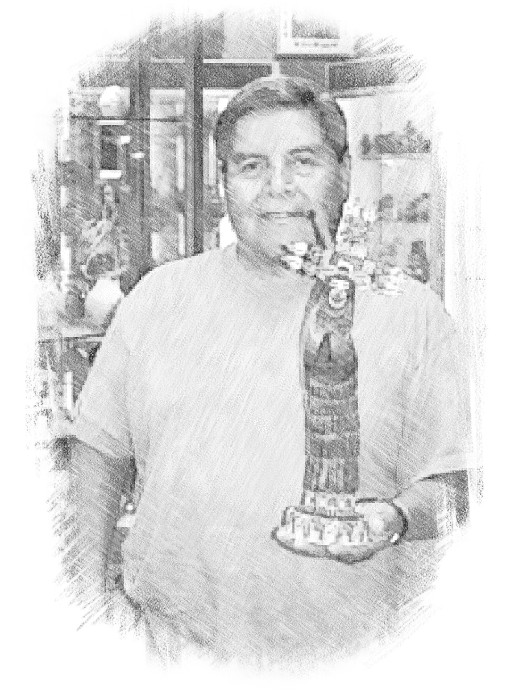
Loren Phillips
(1942-2025)
Loren Phillips is a top prize-winning Hopi Carver. His one-piece dolls are considered among the finest carvings in the history of Hopi art. Loren’s sculptural style often is compared with Michelangelo. Like the Italian Renaissance master, Loren carefully observed natural forms.
Source: Adobe Gallery
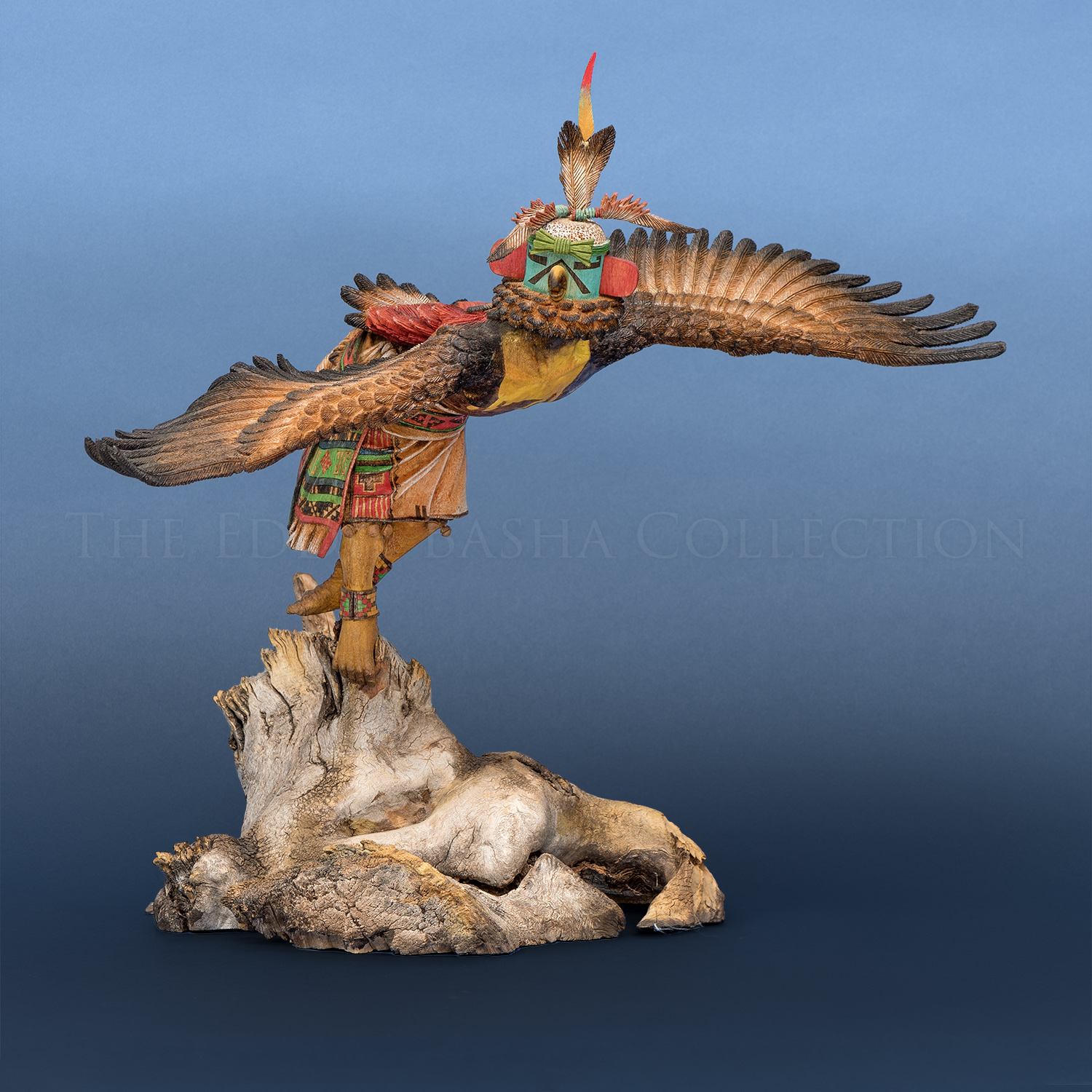
Eagle Dancer
Artist: Loren Phillips (1942-2025)
Description: Cottonwood Tree Root | Dimensions: 19 ½”h x 22”w x 12 ½”dkatsina
The eagle is revered by the Hopi as it is a part of their creation story. Upon emerging from the underworld, their ancestors met the eagle and asked its permission to live on the land. Hence, the Eagle (Kwahu) Katsina is highly sought after and frequently depicted. Loren Phillips, whose “Eagle Dancer” is shown here, is one of the most highly-skilled and world-renowned amongst the Hopi carvers. This particular eagle dancer is strategically balanced on its root base on one foot … not an easily mastered feat.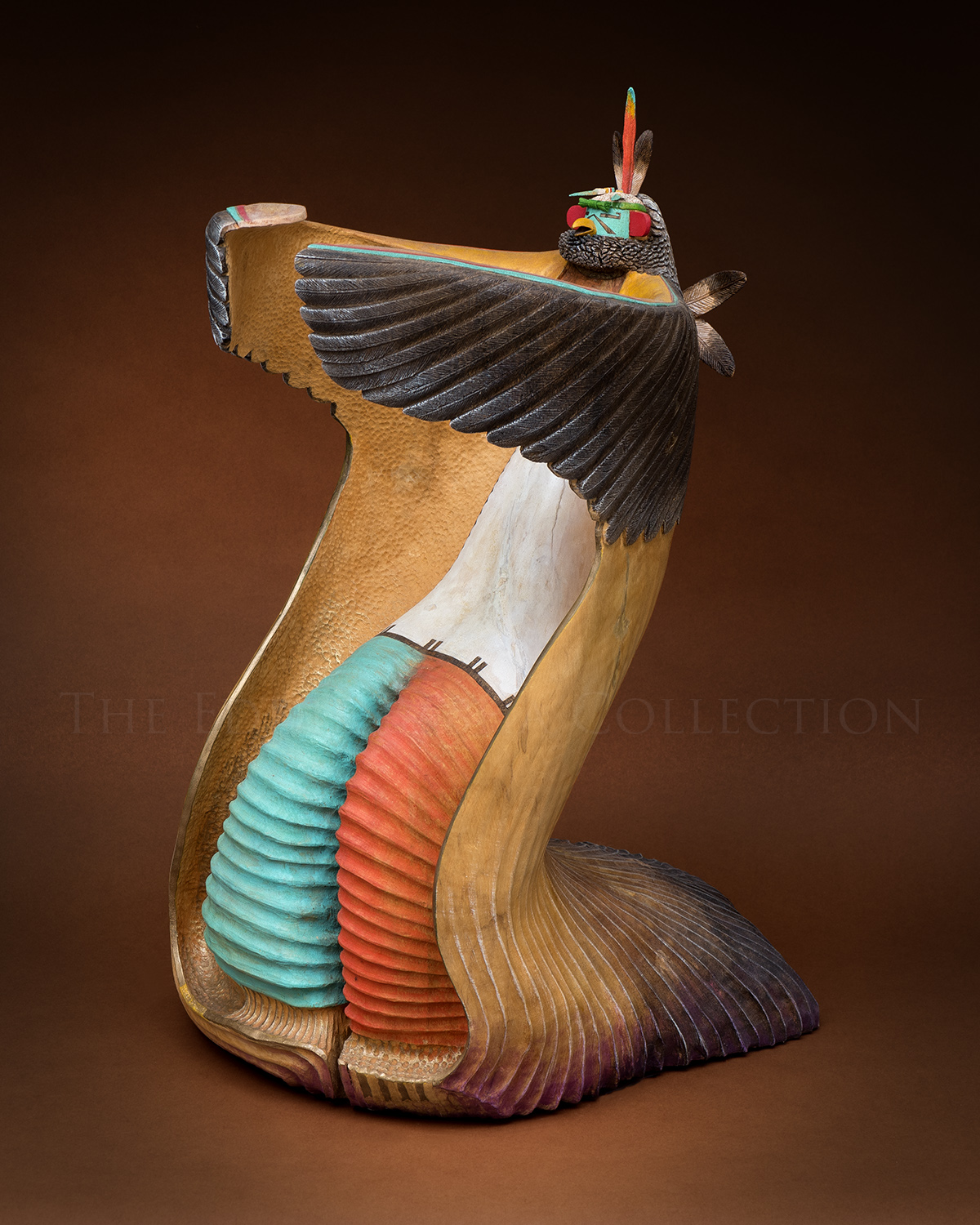
Cobra Katsina
Artist: Loren Phillips (1942-2025)
Description: Cottonwood Tree Root | Dimensions: 27”h x 18”w x 17”dkatsina
This is a rather different katsina carving style for Loren Phillips since his expertise usually falls in the realm of realistic depictions of the human figure. This piece is much more stylized and appears to have emerged directly from the natural curves of the wood exuding grace and elegance.
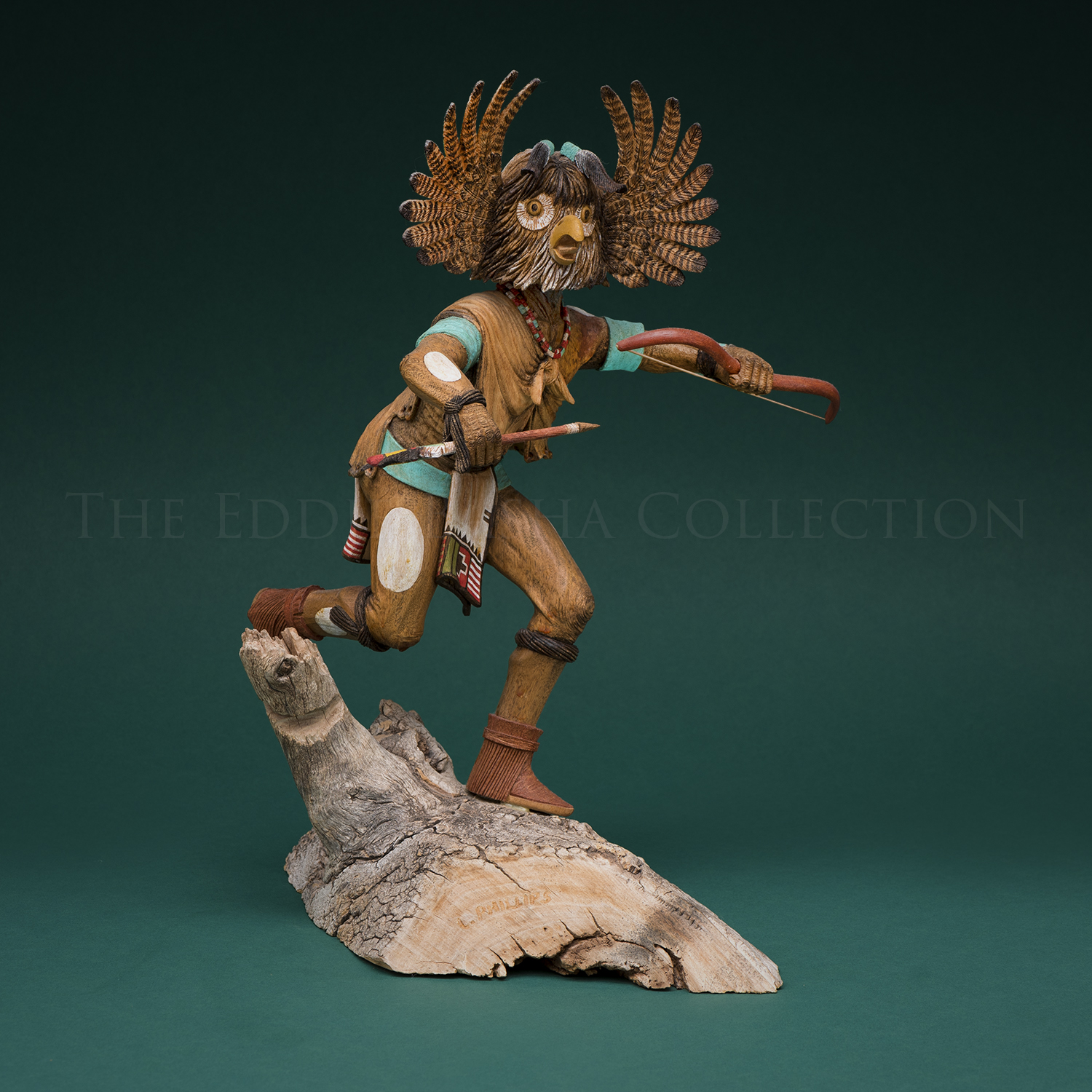
Owl - Mongwu
Artist: Loren Phillips (1942-2025)
Description: Cottonwood Tree Root | Dimensions: 17”h x 16”w x 12”dkatsina
The Owl, or Mongwu, is the leader of the warrior katsinam and brings the whips to the summer dances to discipline the clowns for their un-Hopi-like behavior. Standing at the edge of the dance circle while the clowns perform, Mongwu glaringly disapproves of their actions. Near the end of their performance, a parliament of mongwu swoop in and metaphorically beat the clowns with whips, drench them with water and leave them in a heap on the plaza. Mongwu are considered sorcerers.
Famed Hopi carver, Loren Phillips, has participated in both the Santa Fe and Heard Museum Indian Markets for many years.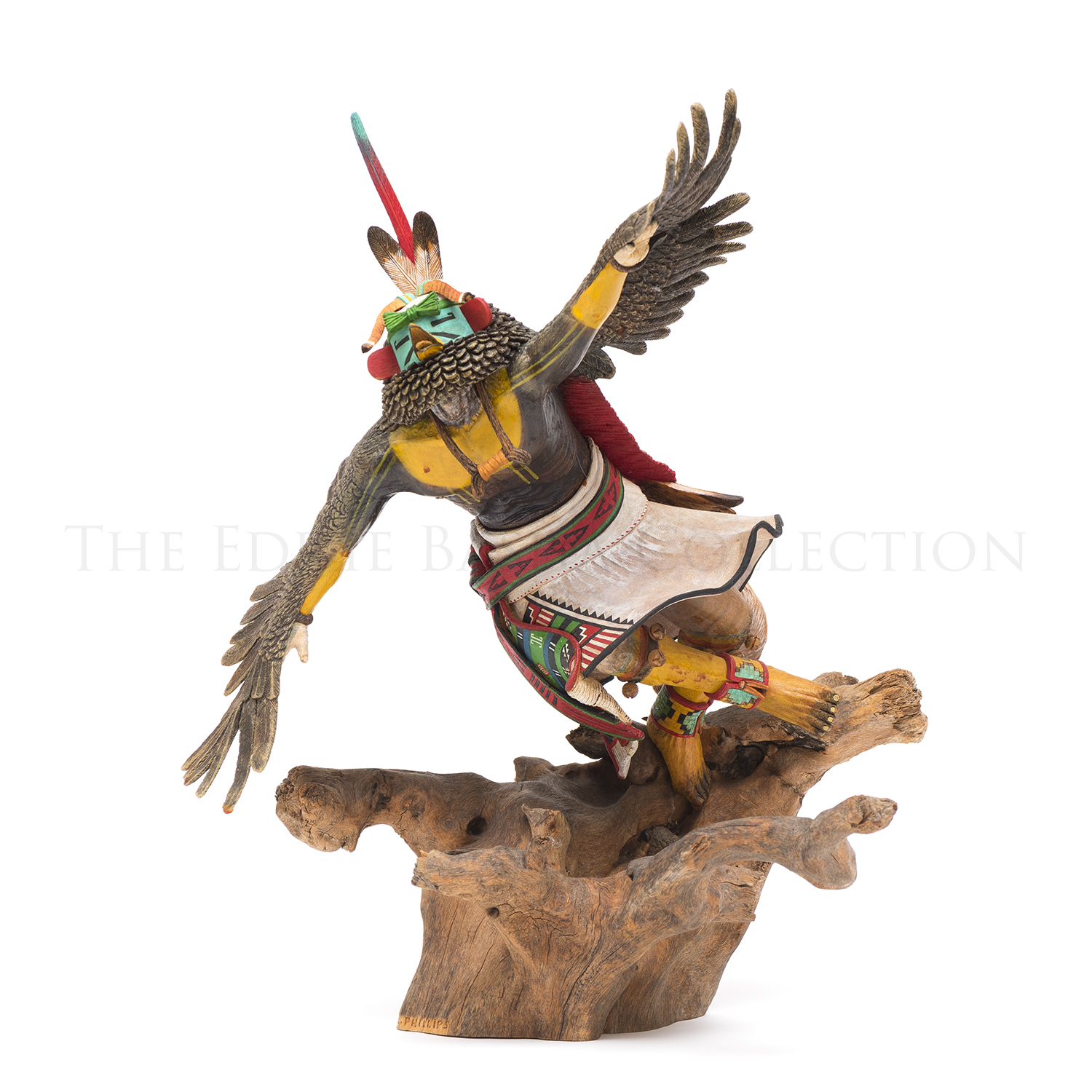
Eagle Dancer
Artist: Loren Phillips (1942-2025)
Description: Cottonwood Root | Dimensions: 19”h x 18”w x 12”dkatsina
Born in the Hopi Village of Moencopi in 1942, Loren Phillips is a husband, father and katsina carving master. Phillips offers may fine details in his katsina dolls such as those shown here in his Eagle Dancer. As a dancer himself, he knows the nuances of the traditional dances as well as the meanings and symbolism he conveys through his carvings. He is a well-known, acclaimed carver and his work is in high demand by museums and collectors alike.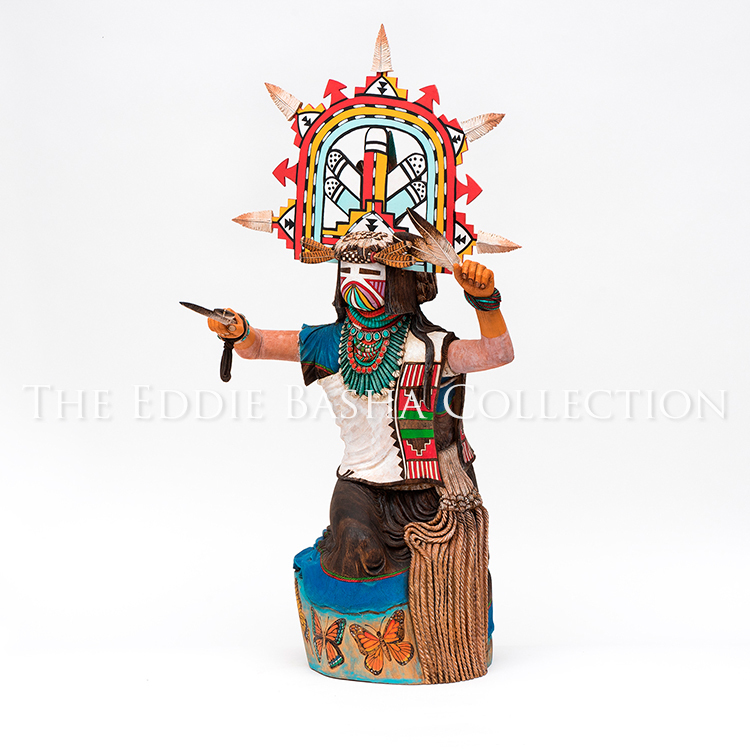
Butterfly Maiden
Artist: Loren Phillips (1942-2025)
Description: Cottonwood Root (2006) | Dimensions: 32”h x 10”w x 10”dkatsina
Loren Phillips offers may fine details in his work such as those seen here in his Butterfly Maiden with her beautiful tableta. As a dancer himself, he knows the nuances of those traditional dances as well as the meanings and symbolism he conveys through his carvings. He is a well-known and acclaimed carver and his work is in high demand by collectors and museums alike.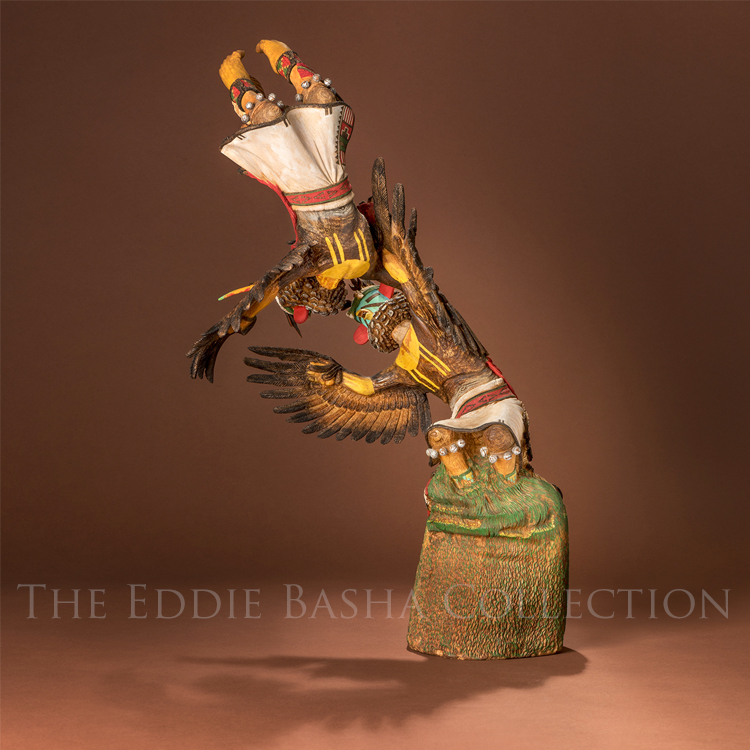
High Spirits
Artist: Loren Phillips (1942-2025)
Description: Katsina (Cottonwood Tree Root) | 26”h x 17”w x 11”dkatsina
An eagle katsina carved by Hopi artist Loren Phillips was once described by Helga Teiwes, author of “Kachina Dolls: The Art of Hopi Carvers,” as “a merging of the human body with the wingspan and stance of an eagle in the wild, a mingling of two realities that evokes the supernatural.” Since that time, Phillips has exceeded that portrayal as evidenced in his subsequent work entitled “High Spirits.” Here, not one, but two eagle spirit dancers not only merge the human form with their wingspan but they also embody the beauty and grace of aerobatic flight, a mingling of three realities that evokes the supernatural. Up close “High Spirits” reveals countless hours of carving exacting feathers, vibrant yet rich color, and jubilant reverence for Hopi cultural.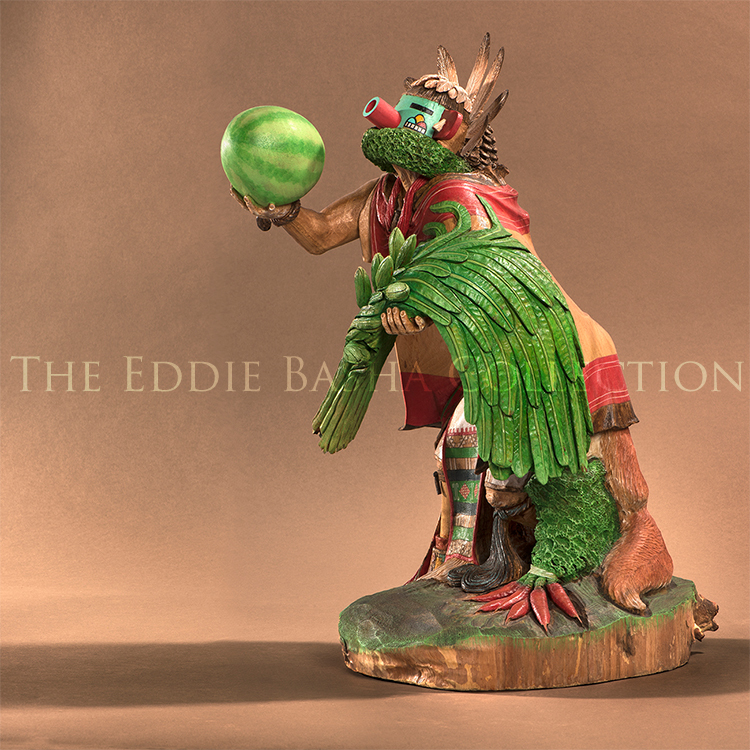
Morning Katsina – Fresh Offering
Artist: Loren Phillips (1942-2025)
Description: Hopi Katsina; Cottonwood Tree Root | Dimensions: 18”h x 12”w x 10”dkatsina
Introduced by the Spanish during the 16th Century, “kawayvatnga” is the Hopi word for watermelon. And, aren’t we glad they did?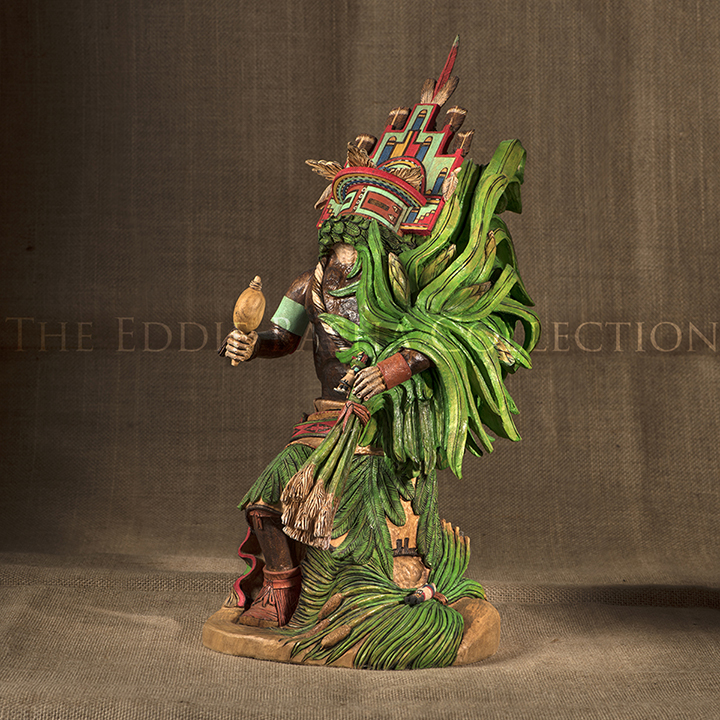
Hemis, the Ripened Corn Katsina
Artist: Loren Phillips (1942-2025)
Description: Katsina (Cottonwood Tree Root) | 19”h x 10”w x 12”dkatsina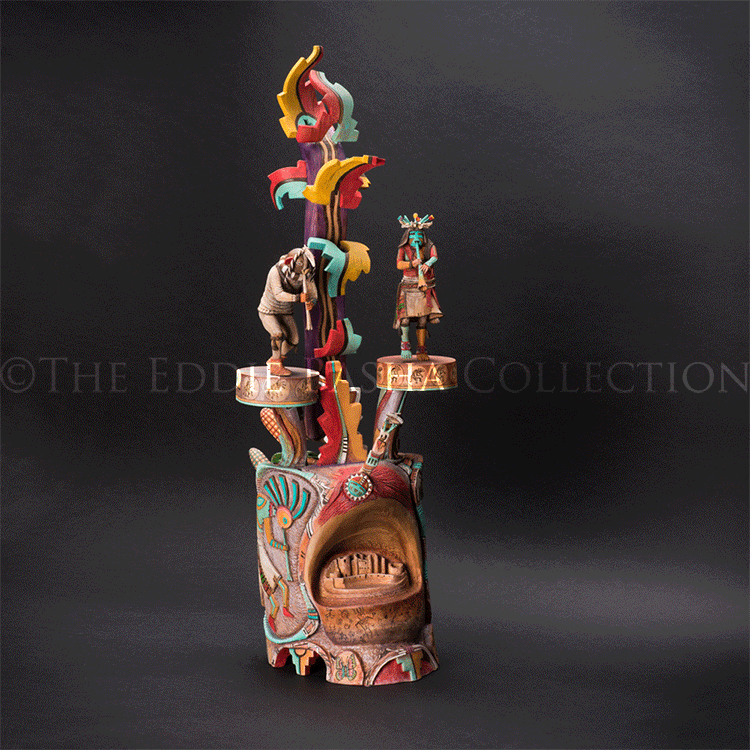
Kokopelli Flute Players
Artist: Loren Phillips (1942-2025)
Description: Cottonwood Tree Root (2005) | Dimensions: 36”h x 13”w x 13”dkatsina
Born in the Hopi Village of Moencopi in 1942, Loren Phillips is a husband, father and katsina carving master. His work is known for its realistic gestures and intricate details. Detail? Yes, indeed! “Kokopelli Flute Players” is flush with them from three-dimensional figures to the skillfully carved pueblo and the abundance of petroglyphs burned into its surface and so much more, this katsina rightfully earned its first place win in the Katsina Division at the 85th Annual Santa Fe Indian Market in 2005. It truly is a masterwork to be
hold!
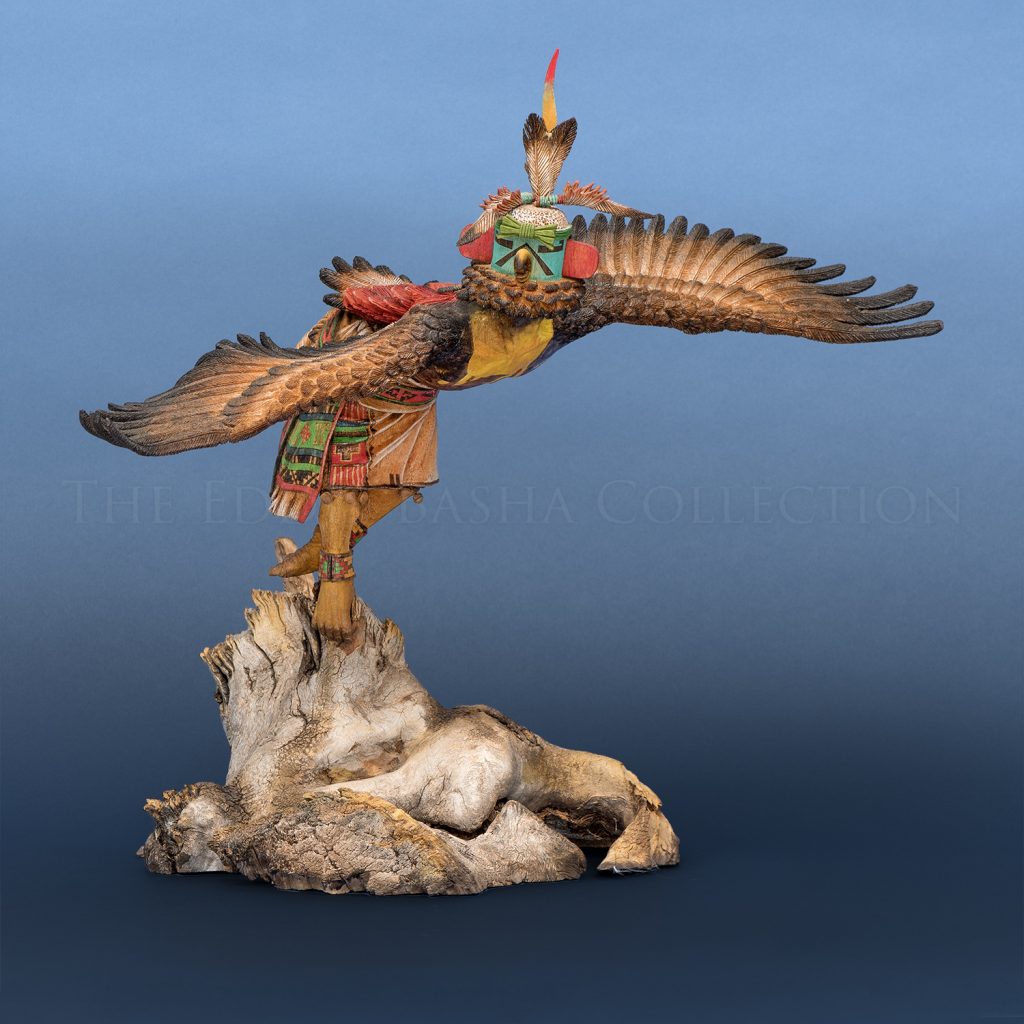 Cottonwood Tree Root | Dimensions: 19 ½”h x 22”w x 12 ½”d
Cottonwood Tree Root | Dimensions: 19 ½”h x 22”w x 12 ½”dThe eagle is revered by the Hopi as it is a part of their creation story. Upon emerging from the underworld, their ancestors met the eagle and asked its permission to live on the land. Hence, the Eagle (Kwahu) Katsina is highly sought after and frequently depicted. Loren Phillips, whose “Eagle Dancer” is shown here, is one of the most highly-skilled and world-renowned amongst the Hopi carvers. This particular eagle dancer is strategically balanced on its root base on one foot … not an easily mastered feat.
Eagle Dancer
Artist: Loren Phillips (1942-2025)
Description:
Cottonwood Tree Root | Dimensions: 19 ½”h x 22”w x 12 ½”d
The eagle is revered by the Hopi as it is a part of their creation story. Upon emerging from the underworld, their ancestors met the eagle and asked its permission to live on the land. Hence, the Eagle (Kwahu) Katsina is highly sought after and frequently depicted. Loren Phillips, whose “Eagle Dancer” is shown here, is one of the most highly-skilled and world-renowned amongst the Hopi carvers. This particular eagle dancer is strategically balanced on its root base on one foot … not an easily mastered feat.
katsinaThe eagle is revered by the Hopi as it is a part of their creation story. Upon emerging from the underworld, their ancestors met the eagle and asked its permission to live on the land. Hence, the Eagle (Kwahu) Katsina is highly sought after and frequently depicted. Loren Phillips, whose “Eagle Dancer” is shown here, is one of the most highly-skilled and world-renowned amongst the Hopi carvers. This particular eagle dancer is strategically balanced on its root base on one foot … not an easily mastered feat.
 Cottonwood Tree Root | Dimensions: 27”h x 18”w x 17”d
Cottonwood Tree Root | Dimensions: 27”h x 18”w x 17”dThis is a rather different katsina carving style for Loren Phillips since his expertise usually falls in the realm of realistic depictions of the human figure. This piece is much more stylized and appears to have emerged directly from the natural curves of the wood exuding grace and elegance.
Cobra Katsina
Artist: Loren Phillips (1942-2025)
Description:
Cottonwood Tree Root | Dimensions: 27”h x 18”w x 17”d
This is a rather different katsina carving style for Loren Phillips since his expertise usually falls in the realm of realistic depictions of the human figure. This piece is much more stylized and appears to have emerged directly from the natural curves of the wood exuding grace and elegance.
katsinaThis is a rather different katsina carving style for Loren Phillips since his expertise usually falls in the realm of realistic depictions of the human figure. This piece is much more stylized and appears to have emerged directly from the natural curves of the wood exuding grace and elegance.
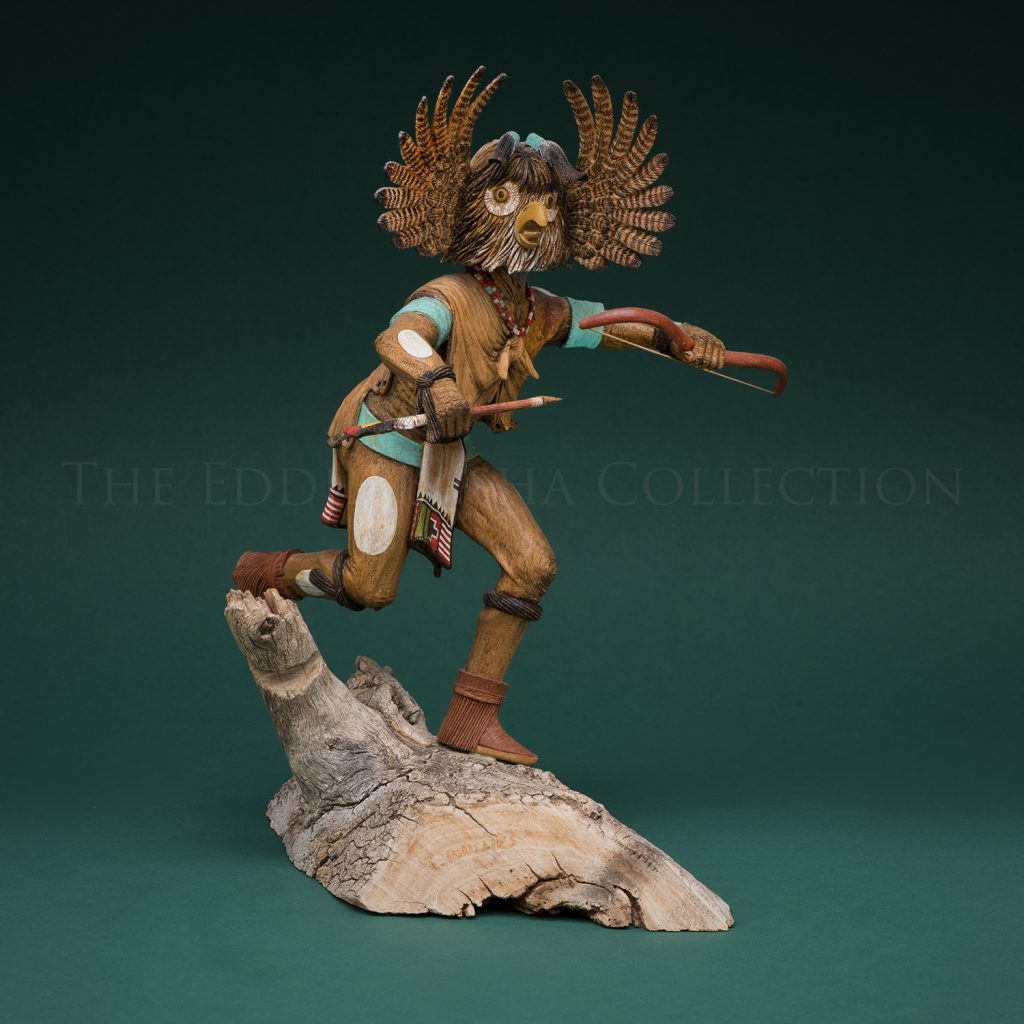 Cottonwood Tree Root | Dimensions: 17”h x 16”w x 12”d
Cottonwood Tree Root | Dimensions: 17”h x 16”w x 12”dThe Owl, or Mongwu, is the leader of the warrior katsinam and brings the whips to the summer dances to discipline the clowns for their un-Hopi-like behavior. Standing at the edge of the dance circle while the clowns perform, Mongwu glaringly disapproves of their actions. Near the end of their performance, a parliament of mongwu swoop in and metaphorically beat the clowns with whips, drench them with water and leave them in a heap on the plaza. Mongwu are considered sorcerers.
Famed Hopi carver, Loren Phillips, has participated in both the Santa Fe and Heard Museum Indian Markets for many years.
Owl - Mongwu
Artist: Loren Phillips (1942-2025)
Description:
Cottonwood Tree Root | Dimensions: 17”h x 16”w x 12”d
The Owl, or Mongwu, is the leader of the warrior katsinam and brings the whips to the summer dances to discipline the clowns for their un-Hopi-like behavior. Standing at the edge of the dance circle while the clowns perform, Mongwu glaringly disapproves of their actions. Near the end of their performance, a parliament of mongwu swoop in and metaphorically beat the clowns with whips, drench them with water and leave them in a heap on the plaza. Mongwu are considered sorcerers.
Famed Hopi carver, Loren Phillips, has participated in both the Santa Fe and Heard Museum Indian Markets for many years.
katsinaThe Owl, or Mongwu, is the leader of the warrior katsinam and brings the whips to the summer dances to discipline the clowns for their un-Hopi-like behavior. Standing at the edge of the dance circle while the clowns perform, Mongwu glaringly disapproves of their actions. Near the end of their performance, a parliament of mongwu swoop in and metaphorically beat the clowns with whips, drench them with water and leave them in a heap on the plaza. Mongwu are considered sorcerers.
Famed Hopi carver, Loren Phillips, has participated in both the Santa Fe and Heard Museum Indian Markets for many years.
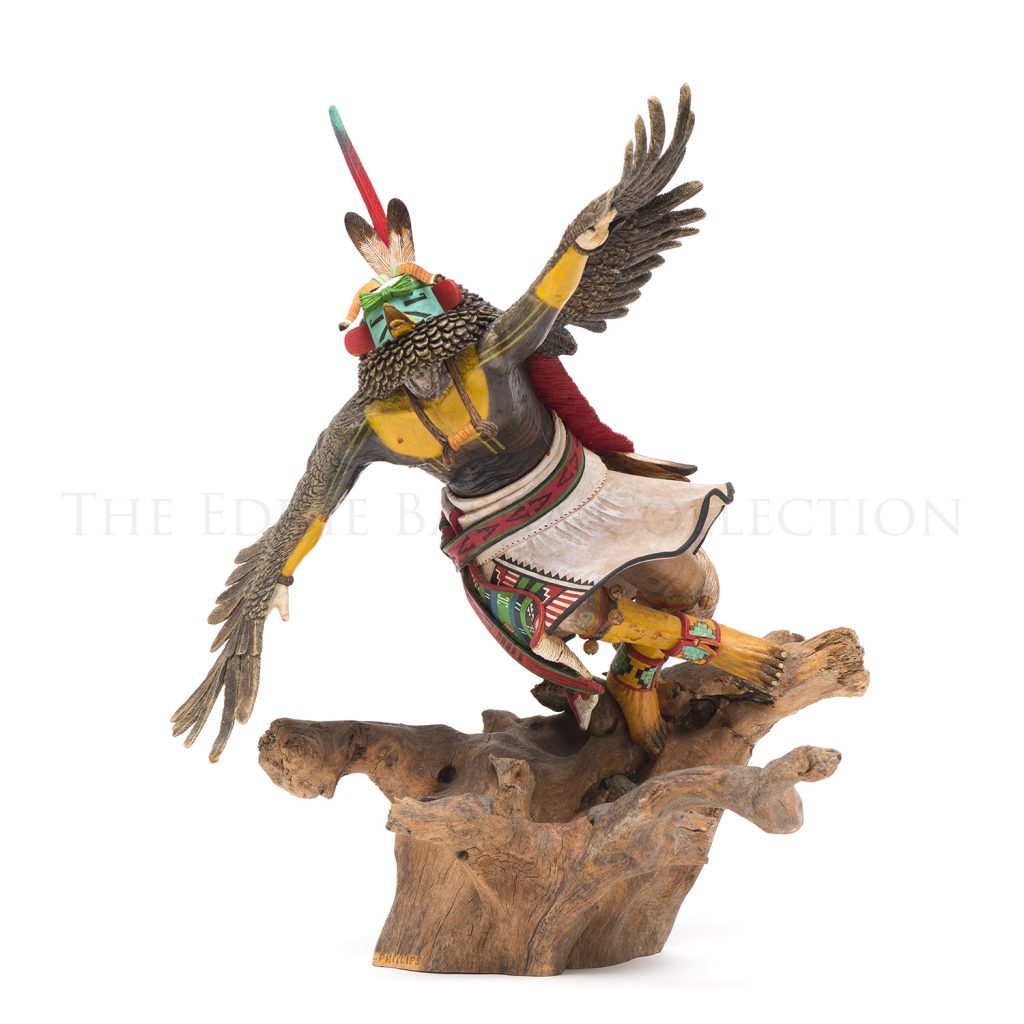 Cottonwood Root | Dimensions: 19”h x 18”w x 12”d
Cottonwood Root | Dimensions: 19”h x 18”w x 12”dBorn in the Hopi Village of Moencopi in 1942, Loren Phillips is a husband, father and katsina carving master. Phillips offers may fine details in his katsina dolls such as those shown here in his Eagle Dancer. As a dancer himself, he knows the nuances of the traditional dances as well as the meanings and symbolism he conveys through his carvings. He is a well-known, acclaimed carver and his work is in high demand by museums and collectors alike.
Eagle Dancer
Artist: Loren Phillips (1942-2025)
Description:
Cottonwood Root | Dimensions: 19”h x 18”w x 12”d
Born in the Hopi Village of Moencopi in 1942, Loren Phillips is a husband, father and katsina carving master. Phillips offers may fine details in his katsina dolls such as those shown here in his Eagle Dancer. As a dancer himself, he knows the nuances of the traditional dances as well as the meanings and symbolism he conveys through his carvings. He is a well-known, acclaimed carver and his work is in high demand by museums and collectors alike.
katsinaBorn in the Hopi Village of Moencopi in 1942, Loren Phillips is a husband, father and katsina carving master. Phillips offers may fine details in his katsina dolls such as those shown here in his Eagle Dancer. As a dancer himself, he knows the nuances of the traditional dances as well as the meanings and symbolism he conveys through his carvings. He is a well-known, acclaimed carver and his work is in high demand by museums and collectors alike.
 Cottonwood Root (2006) | Dimensions: 32”h x 10”w x 10”d
Cottonwood Root (2006) | Dimensions: 32”h x 10”w x 10”dLoren Phillips offers may fine details in his work such as those seen here in his Butterfly Maiden with her beautiful tableta. As a dancer himself, he knows the nuances of those traditional dances as well as the meanings and symbolism he conveys through his carvings. He is a well-known and acclaimed carver and his work is in high demand by collectors and museums alike.
Butterfly Maiden
Artist: Loren Phillips (1942-2025)
Description:
Cottonwood Root (2006) | Dimensions: 32”h x 10”w x 10”d
Loren Phillips offers may fine details in his work such as those seen here in his Butterfly Maiden with her beautiful tableta. As a dancer himself, he knows the nuances of those traditional dances as well as the meanings and symbolism he conveys through his carvings. He is a well-known and acclaimed carver and his work is in high demand by collectors and museums alike.
katsinaLoren Phillips offers may fine details in his work such as those seen here in his Butterfly Maiden with her beautiful tableta. As a dancer himself, he knows the nuances of those traditional dances as well as the meanings and symbolism he conveys through his carvings. He is a well-known and acclaimed carver and his work is in high demand by collectors and museums alike.
 Katsina (Cottonwood Tree Root) | 26”h x 17”w x 11”d
Katsina (Cottonwood Tree Root) | 26”h x 17”w x 11”dAn eagle katsina carved by Hopi artist Loren Phillips was once described by Helga Teiwes, author of “Kachina Dolls: The Art of Hopi Carvers,” as “a merging of the human body with the wingspan and stance of an eagle in the wild, a mingling of two realities that evokes the supernatural.” Since that time, Phillips has exceeded that portrayal as evidenced in his subsequent work entitled “High Spirits.” Here, not one, but two eagle spirit dancers not only merge the human form with their wingspan but they also embody the beauty and grace of aerobatic flight, a mingling of three realities that evokes the supernatural. Up close “High Spirits” reveals countless hours of carving exacting feathers, vibrant yet rich color, and jubilant reverence for Hopi cultural.
High Spirits
Artist: Loren Phillips (1942-2025)
Description:
Katsina (Cottonwood Tree Root) | 26”h x 17”w x 11”d
An eagle katsina carved by Hopi artist Loren Phillips was once described by Helga Teiwes, author of “Kachina Dolls: The Art of Hopi Carvers,” as “a merging of the human body with the wingspan and stance of an eagle in the wild, a mingling of two realities that evokes the supernatural.” Since that time, Phillips has exceeded that portrayal as evidenced in his subsequent work entitled “High Spirits.” Here, not one, but two eagle spirit dancers not only merge the human form with their wingspan but they also embody the beauty and grace of aerobatic flight, a mingling of three realities that evokes the supernatural. Up close “High Spirits” reveals countless hours of carving exacting feathers, vibrant yet rich color, and jubilant reverence for Hopi cultural.
katsinaAn eagle katsina carved by Hopi artist Loren Phillips was once described by Helga Teiwes, author of “Kachina Dolls: The Art of Hopi Carvers,” as “a merging of the human body with the wingspan and stance of an eagle in the wild, a mingling of two realities that evokes the supernatural.” Since that time, Phillips has exceeded that portrayal as evidenced in his subsequent work entitled “High Spirits.” Here, not one, but two eagle spirit dancers not only merge the human form with their wingspan but they also embody the beauty and grace of aerobatic flight, a mingling of three realities that evokes the supernatural. Up close “High Spirits” reveals countless hours of carving exacting feathers, vibrant yet rich color, and jubilant reverence for Hopi cultural.
 Hopi Katsina; Cottonwood Tree Root | Dimensions: 18”h x 12”w x 10”d
Hopi Katsina; Cottonwood Tree Root | Dimensions: 18”h x 12”w x 10”dIntroduced by the Spanish during the 16th Century, “kawayvatnga” is the Hopi word for watermelon. And, aren’t we glad they did?
Morning Katsina – Fresh Offering
Artist: Loren Phillips (1942-2025)
Description:
Hopi Katsina; Cottonwood Tree Root | Dimensions: 18”h x 12”w x 10”d
Introduced by the Spanish during the 16th Century, “kawayvatnga” is the Hopi word for watermelon. And, aren’t we glad they did?
katsinaIntroduced by the Spanish during the 16th Century, “kawayvatnga” is the Hopi word for watermelon. And, aren’t we glad they did?
 Katsina (Cottonwood Tree Root) | 19”h x 10”w x 12”d
Katsina (Cottonwood Tree Root) | 19”h x 10”w x 12”dHemis, the Ripened Corn Katsina
Artist: Loren Phillips (1942-2025)
Description:
Katsina (Cottonwood Tree Root) | 19”h x 10”w x 12”d
katsina Cottonwood Tree Root (2005) | Dimensions: 36”h x 13”w x 13”d
Cottonwood Tree Root (2005) | Dimensions: 36”h x 13”w x 13”d Born in the Hopi Village of Moencopi in 1942, Loren Phillips is a husband, father and katsina carving master. His work is known for its realistic gestures and intricate details. Detail? Yes, indeed! “Kokopelli Flute Players” is flush with them from three-dimensional figures to the skillfully carved pueblo and the abundance of petroglyphs burned into its surface and so much more, this katsina rightfully earned its first place win in the Katsina Division at the 85th Annual Santa Fe Indian Market in 2005. It truly is a masterwork to be
hold!
Kokopelli Flute Players
Artist: Loren Phillips (1942-2025)
Description:
Cottonwood Tree Root (2005) | Dimensions: 36”h x 13”w x 13”d
Born in the Hopi Village of Moencopi in 1942, Loren Phillips is a husband, father and katsina carving master. His work is known for its realistic gestures and intricate details. Detail? Yes, indeed! “Kokopelli Flute Players” is flush with them from three-dimensional figures to the skillfully carved pueblo and the abundance of petroglyphs burned into its surface and so much more, this katsina rightfully earned its first place win in the Katsina Division at the 85th Annual Santa Fe Indian Market in 2005. It truly is a masterwork to be
hold!
katsinaBorn in the Hopi Village of Moencopi in 1942, Loren Phillips is a husband, father and katsina carving master. His work is known for its realistic gestures and intricate details. Detail? Yes, indeed! “Kokopelli Flute Players” is flush with them from three-dimensional figures to the skillfully carved pueblo and the abundance of petroglyphs burned into its surface and so much more, this katsina rightfully earned its first place win in the Katsina Division at the 85th Annual Santa Fe Indian Market in 2005. It truly is a masterwork to be
hold!